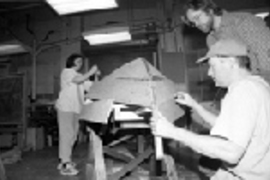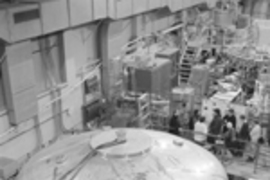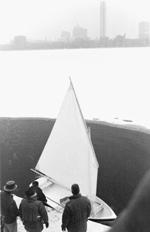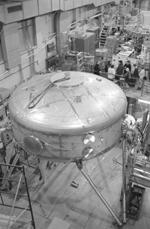IAP series designed to spark renewed interest in research
A new IAP series, the Spark Forum, featured 10 talks by faculty members, each followed by an informal reception and small off-campus dinner for the professor and about 10 students who signed up on the web.
As chair of the IAP policy committee, Professor David Mindell said he planned the series with a nod to the millennium, selecting junior faculty who were asked to present their visions of the future of their fields of expertise.
The goal of the series, sponsored by the Office of the Dean of Students and Undergraduate Education, was "to reignite students' excitement about being at MIT," said Professor Mindell of the Program on Science, Technology and Society.
"Students come to MIT because of the research here, but in their first couple of years, they do primarily coursework and can lose sight of research. They don't really get a broad view of what goes on here. So we set up a series of talks covering a wide spectrum of things to try to reignite that enthusiasm," he said.
All faculty who spoke are involved in interdisciplinary research, and all were asked to talk about how they chose their fields.
"The faculty get pretty excited when they talk about their research, and it's good to provide a way for them to share that with the students," said Professor Mindell, the Dibner Assistant Professor of the History of Engineering and Manufacturing.
Talks were scheduled from 3:30-5pm with a reception following. Afterwards students and the speaker headed to dinner at a local restaurant, where they continued their conversations about research, MIT and life. Students were able to sign up for dinner with the speaker of their choice at a special web site.
In addition to the three talks described below, the series also included Professors Justine Cassell of media arts and sciences on "Nudge, Nudge, Wink, Wink: The Future of Conversation between Humans and Machines"; Ely Dahan of management on "Using the Internet to Get Close to Customers and Design Insanely Great Products"; Tina Voelker of civil and environmental engineering on "Clean Water: A Chemist's Outlook on Sustaining the Health of Aquatic Environments"; Peter So of mechanical engineering on "Optical Imaging: Capturing Biology in Action"; John-Paul Clarke of aeronautics and astronautics on "The Future of Air Traffic Control: Can We Do It Safely and Reliably Without Harming the Environment?"; Ned Hall of linguistics and philosophy on "Is Quantum Physics Inconsistent? (And Does It Matter If It Is?"); and Sebastian Seung of brain and cognitive sciences on "Towards a Unified Theory of the Brain: My Journey from Physics to Neurobiology."
Denise Brehm
Baker's yeast extolled as research model
Who loves the lowly eukaryote known as baker's yeast?
"The truth is that no one really cares how budding yeast divides," said Angelika Weis-Amon, assistant professor of biology. "What people do care about is a cell cycle disease called cancer." Ordinary baker's yeast turns out to be such a good model for human cells that many researchers are studying the intricacies of its reproductive process.
Why all the focus on the basic regulatory mechanisms governing cell division? Cancer is a disease of the cell cycle in which cell division has gone haywire. Professor Weis-Amon described the advantages of using yeast in cancer research at a January 11 Spark Forum lecture.
"It was a big surprise to everyone" when researchers found that if yeast is missing a crucial protein needed for cell division, a human gene implanted in the yeast can take over to produce the needed protein, she said. "After that discovery, the field progressed at an incredible speed," said Professor Weis-Amon, who is particularly interested in how mitosis, or the dividing up of genetic material, is regulated.
In addition to being a good model for human cell division, yeast is "cheap, nonhazardous and fast," she said.
In the next 25 years, researchers would like to see a detailed molecular understanding of all proteins involved in the cell cycle, how the cycle is controlled by developmental signals, and assays for profiling individuals with increased susceptibility for certain types of cancer.
Deborah Halber
Mullainathan mulls psychology, finance
The study of financial markets without use of psychological tools can be dull; "adding psychology offers some fascinating insights," said Assistant Professor of Economics Sendhil Mullainathan in a January 19 Spark Forum talk, "The Psychology of Financial Markets."
In the beginning were "chartists -- guys in the 1930s and 1940s who looked at patterns in prices and made trades" based on those curves, he said. No psychology applied. The 1950s and 1960s brought the theory of efficient markets and the practice of arbitrage. Still, no psychology applied; "weird patterns could be arbitraged into submission."
But psychology can dramatically affect how people behave in relation to financial markets, and it may help predict how markets will behave, Professor Mullainathan said. "People are remarkably overconfident. They trust their own judgment way too much. They get overly excited about recent good performance. They have loss aversion and will even take risks to avoid selling. Not wanting to face the pain of realizing a loss, people hold onto losers too long and sell winners too quickly."
His advice to a friend with plenty of money to invest? "Whatever you do, don't trade. Individuals trading on their own actively underperform," he said, advocating investment through a fund manager.
"So how do we make money in the market?" he asked. The answer, he suggested, is to be less vulnerable to, well, human psychology.
Sarah H. Wright������
Stein traces increasing reach of computers
Computers are quickly becoming members of a community in which they will eventually "disappear" as they are integrated into -- and interact with -- more and more objects like cars and chalk, said Associate Professor Lynn Andrea Stein at an IAP Spark Forum talk on January 20.
As an example, she cited the intelligent room project she is working on at the Artificial Intelligence Laboratory. Computers embedded within the room, coupled with equipment such as cameras and VCRs, allow the room to respond to a user's needs. "So the architecture within this room is one full of these things interacting," said Professor Stein of the Department of Electrical Engineering and Computer Science.
Networks such as the World Wide Web are also "communities of computers that are cooperating to make sure information gets to the people who are asking for it," she said.
As computers move from their original role as powerful calculators to interacting members of a community, "our job as computer scientists is to figure out what kinds of interactions can best be facilitated this way," Professor Stein said.
Asked later for her views on teaching computer science, she replied that "any well-educated computer scientist should know something about computer systems and how they work, the theory of computation, and something about applications." They should also "know how to write a program and how to debug and modify it," though these latter two skills "are things less often taught."
Elizabeth A. Thomson
Just a spoonful of sugar
Attendees at "Kitchen Chemistry" on January 19 were most enthusiastic about trying the latest in cooking utensils -- the blowtorch.
As she waved the flame over dishes of cr��me brulee, Patti Christie, an instructor in the Experimental Studies Group (ESG), explained that at about 350���F, sugar carmelizes -- turns brown and hard. The process known as the Mallard reaction (named for a French chemist) produces a ring-shaped molecule as well as more than 100 other reaction products, she said.
Attendees created several dishes from recipes provided by Dr. Christie (PhD 1996 in chemistry). While they munched on the results, she answered some questions about the foods they used. For example, chopping onions makes a cook's eyes water because they contain a chemical that produces a lachrymator when the cells are disturbed and exposed to air. This lachrymator dissolves in eye fluids and produces small amounts of irritating sulfuric acid.
Why do we knead bread dough? Because the process aligns the long, tangled gluten molecules in flour, making the dough more elastic. Why are hot peppers hot? Because of a substance called capsicum, which is also a natural preservative and appetite booster. Hot peppers are frequently used in cuisines of hot climates because they induce sweating, which helps cool the body, and they also "swamp the telltale taste of spoilage" that's a problem in hot places, particularly where there is no refrigeration, Dr. Christie said.
These and other food chemistry insights can be found in Harold McGee's On Food and Cooking, she noted. The IAP course was a preview of a for-credit spring semester seminar.
Alice C. Waugh
Hows and whys of nuclear reactor
Subatomic particles produced by the MIT Research Reactor are aiding research in areas ranging from cancer treatment to the development of better materials.
At a recent IAP tour of the facility, Edward Lau (SM 1991, NUE), superintendent of operations, spent some two hours covering the basics of nuclear fission and how the reactor works, and showing participants the apparati for key experiments. One of these was built by Professor Emeritus Clifford Shull, who won a 1994 Nobel prize for his work with neutrons (the particles the reactor was created to produce).
Mr. Lau emphasized that "this reactor does not produce electricity. We operate it to produce neutrons," which in turn are used in many ways.
For example, in one project researchers are creating better semiconductors. Neutrons sent through a silicon ingot turn some of the silicon into phosphorus. This "doping" with phosphorus allows the material to conduct faster. And unlike conventional techniques, the resulting phosphorus is distributed evenly within the silicon ingot, rather than primarily on the surface.
Mr. Lau also noted that a new medical facility at the reactor is nearing completion. Since about 1994, neutrons from the reactor have been used to treat a brain cancer. However, the medical facility used to that end, located in the facility's basement, "was too far away from the core," he said. As a result, a treatment lasted three hours. "With the new facility it should take five minutes."
Elizabeth A. Thomson
Research center focuses on oar, wheel, rod and bat
Cyclists and fishermen alike stand to benefit from a new MIT center that couples researchers' engineering skills with an interest in sports.
At a January 6 IAP talk, Kim B. Blair described current and upcoming projects through the Center for Sports Engineering. Established last August, the center "focuses on new technologies and products to enhance all aspects of the sporting experience," said Dr. Blair, its director.
MIT has a long history in sports engineering. Over the years, for example, researchers in the Department of Aeronautics and Astronautics, where the new center is based, have developed vibration control systems for skis and tested tennis balls and rackets. "But these activities have always been conducted in individual labs and basements. We want to give them a home," Dr. Blair said.
Another reason for creating the new center is education. Key steps in engineering are to conceive, design, implement and operate. In the aerospace industry, however, this product development cycle can take up to 20 years. The new center will allow "student- or class-size products," Dr. Blair said. The development cycle for sports equipment is only one to four years.
Current projects through the center include selecting a softball that balances safety and fun for the Eastern Massachusetts Senior Softball League. The center is also creating a modern testing facility for competitive cyclists and triathletes.
Projects that Dr. Blair hopes to begin this spring include an instrumented rowing shell to detect parameters such as rowers' heart rates and strain on the oars, aerodynamic bike racing wheels, an automated strike zone detection system, and an actively controlled fishing rod.
A final reason for creating the new center: "the market is always ready for new ideas and it needs engineering expertise," he said. Last year he brought his triathlon bike to the MIT wind tunnel for testing, "and in 15 minutes Professor Mark Drela rattled off 20 things that are wrong with the design of the bike, and this is an expensive bike!"
Elizabeth A. Thomson
Plasma center tour offers view of experiment 'spaceship'
A massive vessel reminiscent of a spaceship, complete with silver dome and legs, was one of the more startling stops on a Plasma Science and Fusion Center tour last week.
The tour, part of the center's IAP Open House, allowed visitors to see for themselves some of the experiments PSFC researchers are conducting to understand electrically charged gases -- plasmas -- and their application to producing power by nuclear fusion. When confined, some plasma nuclei fuse, releasing energy.
The "spaceship," for example, is key to the Levitated Dipole Experiment, or LDX. It's a new approach to nuclear fusion in which MIT and Columbia University scientists hope to magnetically levitate a superconducting ring about three feet in diameter in a vacuum chamber about 16 feet in diameter (the "spaceship"). Plasma will then be confined by following magnetic fields that encircle the floating ring.
Darren Garnier, a PSFC visiting scientist from Columbia, said the superconducting ring should be completed this fall. The researchers hope to create a plasma in the vessel about a year from now.
The open house also included a talk and tour about Alcator C-Mod, the PSFC's principal experiment on nuclear fusion. In Alcator C-Mod, the plasma is confined in a doughnut shape via magnetic fields. The machine itself isn't currently visible, since it's encased in a giant "thermos" for cooling with liquid nitrogen. However, people on the Alcator C-Mod tour led by Yongkyoon In, a graduate student in nuclear engineering, could view some of the more than 20 diagnostic instruments extending from the machine.
MIT researchers are now upgrading these instruments, which measure such things as temperature and current density. In a talk earlier in the day, PSFC Research Scientist John Rice noted how new diagnostics have shown that there is a very steep gradient of plasma parameters near the edge of the plasma. For example, the researchers found that the electron temperature drops by a factor of 10 over just two centimeters.
Elizabeth A. Thomson
Charm School to make annual appearance
How do you ask for a date? Should you speak to strangers in an elevator? At what point in an interview do you ask about salary? What do you say in a thank-you note for a gift you hate? Is it rude to talk on a cell phone on the T? Which fork do you use?
These questions and many others will be answered during the seventh Charm School tomorrow (January 22) in Lobbies 7 and 10 and the Bush Room (10-105). Etiquette-related subjects will be taught from noon-4pm. No registration is required. The one-day semester ends with "Commencement" ceremonies in Lobby 10 from 4:30-5pm. The schedule:
Noon
- Opening ceremonies featuring the Logarhythms, Lobby 7. Classes start (Lobbies 7 and 10)
2pm
Who Wants to be a Charminaire" with host Samuel Jay Keyser, Lobby 7
Ballroom Dance lessons/exhibition (refreshments offered), Lobby 13
Commencement check-in starts, Lobby 13 -- redeem your Charm School credits
3pm
- Door prize drawings, Lobby 13 ($50 gift certificates to J. Crew, Abercrombie & Fitch and Banana Republic; winners must be present to claim prizes)
4pm
Final ballroom dance performance, Lobby 13
Commencement lineup, Lobby 13
4:25pm
Graduate prize drawings, Lobby 13.
"Bachelor's degree" earns a $25 certificate to Miracle of Science; "master's" earns a $50 certificate to Cheesecake Factory; "PhD" earns a $75 gift certificate to Sydney's Grill at University Park Hotel (winners must be present to claim prizes)
4:30pm
- Chorallaries lead Commencement procession; Commencement featuring Dean of Charm Travis R. Merritt, Lobby 10
A version of this article appeared in MIT Tech Talk on January 26, 2000.















